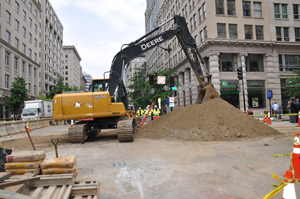Around the Water Cooler: Avoiding that Sinking Feeling
By Aaron Ferster
As if Washington, DC commuters didn’t face enough challenges navigating to and from work, those who travel by car were confronted with a new one late last week: a giant sinkhole began to consume 14th Street, a key route connecting downtown with bridges and major highways just beyond.
Located only a few blocks from the White House, the crevasse grew to some 15-feet across, leading authorities to close the road in both directions for days. (As I write this, only the south-bound lanes had re-opened.)
Since its appearance, the sinkhole and its aftermath have dominated traffic reports and drawn a steady stream of curious onlookers from nearby office buildings and surrounding neighborhood tourist spots. The ever expanding meme has even sparked a Twitter account (@14thStSinkhole), ripe with parody. (As a frequent bike commuter, my favorite interaction: “I am the stuff of dreams!! RT @hellbucci: Had a dream that as I biked to work, I fell into the @14thStSinkhole. Not cool sinkhole.”)
But all joking aside, sinkholes and other symptoms of our aging water infrastructure are serious business. This particular incident apparently evolved from an ill-placed storm drain, which clogged and sent rainwater free-flowing under the street where it eroded the underlying ground and destroyed a 54-inch brick sewer line built in the 1800s.
According to a D.C. Sewer and Water Authority news release, the already complex repairs were made more difficult due to a number of utility lines and old, buried trolley tracks under the street. A hidden hole for entry from the street, identified on DC Water records, was eventually located eight feet below the surface of the road, paved over many times through the years.
Such challenges related to the nation’s aging water infrastructure are nothing new to EPA engineers and scientists who are working to identify critical research needs and develop, test, and demonstrate innovative technologies to reduce the cost and increase the effectiveness of existing or new water infrastructure.
As reported by fellow blogger Sarah Blau (see Is Your Toilet Leaking), “EPA researchers are looking at ways to assess water infrastructure for leaks without disrupting water supply for consumers (i.e. avoiding water shut-offs or pipe excavations). Other research is focused on preventing leaks from occurring, specifically by examining the relationship between water chemistry and plumbing life expectancy.”
To learn more, visit EPA’s Aging Water Infrastructure Research webpage. You can also read about a specific research project exploring pinhole leaks in copper pipes (“Problems with Pinhole Leaks in Your Copper Water Pipes”) in our Science Matters newsletter. It’s all part of our effort to share how EPA researchers are working to solve all sorts of problems—and I can guarantee that you’ll find the reading a lot cooler than riding your bicycle into a sinkhole!
About the Author: Aaron Ferster dodges sinkholes and other obstacles to and from his job as an EPA science writer, where he edits the It All Starts with Science blog.


May 30, 2013 @ 15:28:18
We Don’t Know That What Will Happen Next…..
Just the baby knows why they cries who feel that they could meet by the experiences. Urban cities have been accumulated of various sink that they felt. They didn’t like it because they didn’t chance to play on. But destiny talks different. We are surrender. We stay there…….
May 30, 2013 @ 15:29:42
deep water the big spill picture newspaper the bp search oil antarktis
May 30, 2013 @ 16:33:33
Very nice article. Thanks!
May 31, 2013 @ 12:25:38
Thank you!
Water Infrastructure: Meeting the Challenges Ahead | Green Jobs
Jun 13, 2013 @ 07:32:39
[…] because most of our drinking water infrastructure is hidden from sight. You might only notice it when it fails, like the water main near my house a few weeks ago. I walked down the street and saw water shooting […]